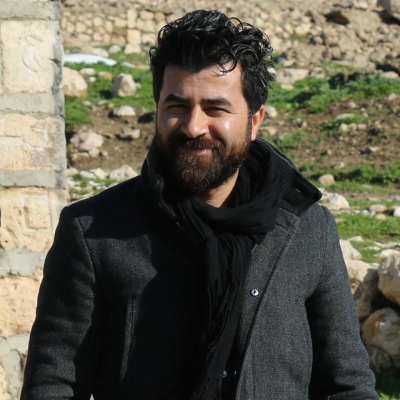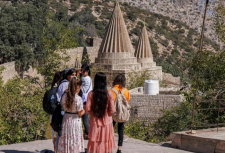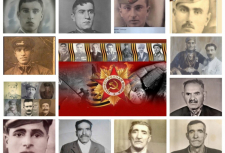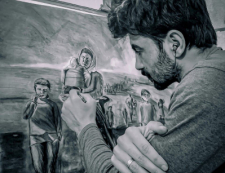Political participation of minorities in Iraq
Majid Hassa
Saad Salah

The political participation of the yezidis
Before the second Gulf War in 1991, the social structure of the Yezidis was united to a certain extent and was represented by the Emiri Institution headed by Emir Tahseen Bek and the Yezidi Spiritual Council. The conditions changed as a result of developments that took place after 1991 (including the imposition of a safe zone by the United Nations Security Council Resolution 688, adopted on 5 April, 1991). It was then that Kurdish parties and militia controlled areas north of the 36th parallel including three major provinces, among them is Dohuk, where there were four large Yezidi population concentrations. Kurdish parties, with the administrative and security vacuum created after the withdrawal of the Iraqi state institutions from these provinces, decided to hold the first regional elections in Iraqi Kurdistan in 1992 with the participation of a number of opposition political parties and movements.
Yezidis Divided Between the Central Government and the Kurdistan Region
These developments divided the Yezidi community between the Central Government and the Kurdistan Region leaving them politically unorganized in areas under central authority. They were unable to organize because of the dominance of the Baath party in the political system. This situation continued until the toppling of the regime in Baghdad in 2003. In Kurdish areas, there were some political, cultural, and social developments, most important of which was the agreement reached between the “first elites – the elites of the first generation” of the Yezidi intellectuals to establish a cultural heritage and a Yezidi history center. And thus came to life the Lalsh Cultural and Social Center in 1993. Notwithstanding this cultural and social development, the Yezidis did not establish any political party because of the influence and dominance of the main Kurdish parties on the scene, especially the Kurdistan Democratic Party (KDP), the Patriotic Union of Kurdistan (PUK), and the Kurdish nationalist Peoples’ Democratic Party. In their political programs and activities, those parties considered the Yezidis as part of the Kurdish ethnic heritage. From their point of view, there was no need to create a political party for the Yezidis based on religious differences as the Yezidis share ethnic origins with the Muslim Kurds.
This historical background is necessary to explain why the Yezidis were represented by the Kurdish parties in the political process after 2003.The result of this approach was that Yezidis were encouraged to join Kurdish parties on a large scale in the areas of the Dohuk province and they became members of the various Kurdish parties, while the role of Yezidi elites became limited to cultural activities. During the outbreak of civil war among the main Kurdish movements in the 1980’s, the Yezidis avoided any involvement in the conflict and many of them, who were members of Kurdish parties, resigned and sought refuge in a number of European countries, while others permanently abandoned politics.
The Political Map of Movements and Political Currents which represent the Yezidis
There is no one comprehensive political entity or current that represents Yezidis in Iraq. But in the midst of post-2003, some Yezidis formed a political party motivated by the interim authority resolutions and those of the Governing Council. The party was declared under the name of the “Yezidi Movement for Reform and Progress”, and was headed by Amin Farhan Jeju and Hamad Matwe (who later walked out of this party and formed his own party, the Yezidi Progress Party in Sinjar). The influence of the Yezidi Movement for Reform and Progress had become strong in Sinjar, but not in the Walati (Shikhan) area. This is because it was not allowed to practice its activities and extend its influence in areas which were directly under the region’s authority, according to the claims of the movement’s leaders.
Kurdish parties had a different vision than that of the Yezidi Movement for Reform and Progress on the issue of Yezidi identity because the latter considers the Yezidi identity as a combination of independent ethnic and religious elements, different than those of the Arabs and Kurds, while the former, particularly the KDP, considers the Yezidis as part of the Kurdish national identity. This theoretical difference created a competition regarding who might ultimately dominate Yezidi areas. Other organizations were also formed such as the Yezidi Democratic Gathering, which was announced in the city of Hanover, Germany.
In its political statement, it said that it focuses on “achieving recognition of the Yezidi religion and having it enshrined in the Iraqi Constitution and in the Kurdistan Region’s Constitution and the recognition that all Yezidi areas are part of the Kurdistan Region.” the statement lists some other goals demonstrating that it is an organization created by Yezidis in the diaspora and it introduces itself as a democratic organization with political goals. It also declared that it “adopts a moderate thought with a humanitarian open and inclusive vision that encompasses national, ethnic and religious affiliations.
However, it has not been able to build a popular base in Iraq or the Kurdistan Region, especially because its activism in Iraq has gradually diminished. Nevertheless, it represents a current which is ideologically different from others and which stresses “modesty of thought.” Unlike, the Yezidi Movement for Reform, it did not adopt a religious or a nationalistic ideology. The Free Yezidi Democratic Movement (TEVDA) was founded in 2004 and its preparatory committee held its founding congress in the city of Mosul (al-Sukkar Hall), on February 1, 2004. The movement held its first conference February 18 2004 and made Iraq the main center of its activities. It declared that “it is not a class movement and does not target a certain class, but rather aims at embracing all of the Yezidi community”. It also affirmed that it is “hostile to reactionary (backward-thinking), and narrow-minded tribal traditions” and stressed the freedom of women and the building of community awareness. Moreover, it justified its creation by claiming to be founded in response to the absence of an “independent Yezidi policy”. This organization remained active in Sinjar and its role grew after Daesh’s (ISIS) occupation of Sinjar because it served as a link in the formation of the Shangal Protection Forces Vanguards (YPS)
Tags: #yazidisinfo #yazidi #yezidi
Political participation of minorities in Iraq
Majid Hassa
Saad Salah

The political participation of the yezidis
Before the second Gulf War in 1991, the social structure of the Yezidis was united to a certain extent and was represented by the Emiri Institution headed by Emir Tahseen Bek and the Yezidi Spiritual Council. The conditions changed as a result of developments that took place after 1991 (including the imposition of a safe zone by the United Nations Security Council Resolution 688, adopted on 5 April, 1991). It was then that Kurdish parties and militia controlled areas north of the 36th parallel including three major provinces, among them is Dohuk, where there were four large Yezidi population concentrations. Kurdish parties, with the administrative and security vacuum created after the withdrawal of the Iraqi state institutions from these provinces, decided to hold the first regional elections in Iraqi Kurdistan in 1992 with the participation of a number of opposition political parties and movements.
Yezidis Divided Between the Central Government and the Kurdistan Region
These developments divided the Yezidi community between the Central Government and the Kurdistan Region leaving them politically unorganized in areas under central authority. They were unable to organize because of the dominance of the Baath party in the political system. This situation continued until the toppling of the regime in Baghdad in 2003. In Kurdish areas, there were some political, cultural, and social developments, most important of which was the agreement reached between the “first elites – the elites of the first generation” of the Yezidi intellectuals to establish a cultural heritage and a Yezidi history center. And thus came to life the Lalsh Cultural and Social Center in 1993. Notwithstanding this cultural and social development, the Yezidis did not establish any political party because of the influence and dominance of the main Kurdish parties on the scene, especially the Kurdistan Democratic Party (KDP), the Patriotic Union of Kurdistan (PUK), and the Kurdish nationalist Peoples’ Democratic Party. In their political programs and activities, those parties considered the Yezidis as part of the Kurdish ethnic heritage. From their point of view, there was no need to create a political party for the Yezidis based on religious differences as the Yezidis share ethnic origins with the Muslim Kurds.
This historical background is necessary to explain why the Yezidis were represented by the Kurdish parties in the political process after 2003.The result of this approach was that Yezidis were encouraged to join Kurdish parties on a large scale in the areas of the Dohuk province and they became members of the various Kurdish parties, while the role of Yezidi elites became limited to cultural activities. During the outbreak of civil war among the main Kurdish movements in the 1980’s, the Yezidis avoided any involvement in the conflict and many of them, who were members of Kurdish parties, resigned and sought refuge in a number of European countries, while others permanently abandoned politics.
The Political Map of Movements and Political Currents which represent the Yezidis
There is no one comprehensive political entity or current that represents Yezidis in Iraq. But in the midst of post-2003, some Yezidis formed a political party motivated by the interim authority resolutions and those of the Governing Council. The party was declared under the name of the “Yezidi Movement for Reform and Progress”, and was headed by Amin Farhan Jeju and Hamad Matwe (who later walked out of this party and formed his own party, the Yezidi Progress Party in Sinjar). The influence of the Yezidi Movement for Reform and Progress had become strong in Sinjar, but not in the Walati (Shikhan) area. This is because it was not allowed to practice its activities and extend its influence in areas which were directly under the region’s authority, according to the claims of the movement’s leaders.
Kurdish parties had a different vision than that of the Yezidi Movement for Reform and Progress on the issue of Yezidi identity because the latter considers the Yezidi identity as a combination of independent ethnic and religious elements, different than those of the Arabs and Kurds, while the former, particularly the KDP, considers the Yezidis as part of the Kurdish national identity. This theoretical difference created a competition regarding who might ultimately dominate Yezidi areas. Other organizations were also formed such as the Yezidi Democratic Gathering, which was announced in the city of Hanover, Germany.
In its political statement, it said that it focuses on “achieving recognition of the Yezidi religion and having it enshrined in the Iraqi Constitution and in the Kurdistan Region’s Constitution and the recognition that all Yezidi areas are part of the Kurdistan Region.” the statement lists some other goals demonstrating that it is an organization created by Yezidis in the diaspora and it introduces itself as a democratic organization with political goals. It also declared that it “adopts a moderate thought with a humanitarian open and inclusive vision that encompasses national, ethnic and religious affiliations.
However, it has not been able to build a popular base in Iraq or the Kurdistan Region, especially because its activism in Iraq has gradually diminished. Nevertheless, it represents a current which is ideologically different from others and which stresses “modesty of thought.” Unlike, the Yezidi Movement for Reform, it did not adopt a religious or a nationalistic ideology. The Free Yezidi Democratic Movement (TEVDA) was founded in 2004 and its preparatory committee held its founding congress in the city of Mosul (al-Sukkar Hall), on February 1, 2004. The movement held its first conference February 18 2004 and made Iraq the main center of its activities. It declared that “it is not a class movement and does not target a certain class, but rather aims at embracing all of the Yezidi community”. It also affirmed that it is “hostile to reactionary (backward-thinking), and narrow-minded tribal traditions” and stressed the freedom of women and the building of community awareness. Moreover, it justified its creation by claiming to be founded in response to the absence of an “independent Yezidi policy”. This organization remained active in Sinjar and its role grew after Daesh’s (ISIS) occupation of Sinjar because it served as a link in the formation of the Shangal Protection Forces Vanguards (YPS)
Tags: #yazidisinfo #yazidi #yezidi


























